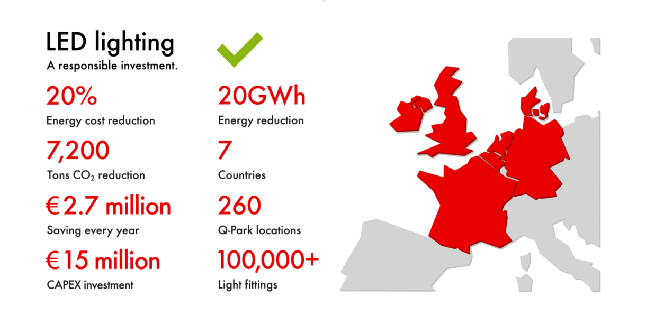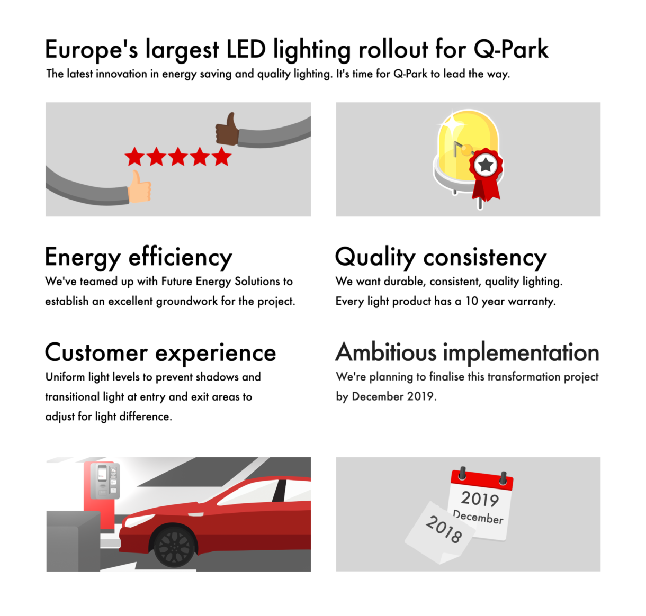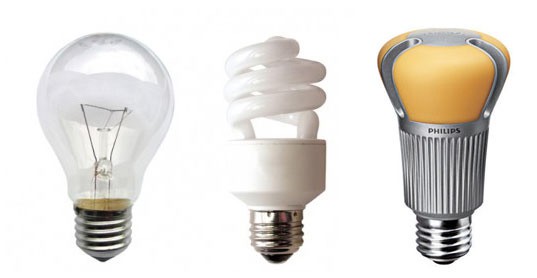LED Transformation Project

The largest project of its kind in Europe
To ensure that its parking facilities take full advantage of the latest energy-saving technologies, Q-Park is partnering with Future Energy Solutions (FES) to install state-of-the-art LED lighting in its parking facilities.
The project is being simultaneously rolled out across the Netherlands (72 sites), Germany (32 sites), France (50 sites), Belgium (22 sites), United Kingdom (47 sites), Ireland (10 sites) and Denmark (15 sites).
The huge investment, exceeding EUR 15 million, going into this LED Transformation Project will add more than 260 locations to the ±100 parking facilities already fitted with energy-saving lighting in the period 2013–2016.
More than 100,000 light fittings will be installed and due to this scale, Q-Park has negotiated a 40% reduction on cost per light product.
The project will be completed by December 2019, bringing forward the benefits and savings. Energy consumption will drop by more than 20%, equivalent to more than EUR2.7 million, accompanied by a CO2 reduction of more than 7,200 tons per year. These savings are cumulative, so by 2025 Q-Park will have saved more than 140 GWh of electricity, equivalent to more than 50,000 tonnes of CO2. In addition to more than 65% energy savings using LED lighting, installing smart lighting controls will contribute to an extra 10% energy reduction. As a result, the project is expected to recoup its costs within 5 years.

Big benefits and savings
EUR 2.7 million cost reduction per year by 2020
EUR 15 million cost reduction by the end of 2025
20 GWh energy reduction per year by 2020
140 GWh energy reduction by the end of 2025
7,200 tons CO2 reduction per year by 2020
50,000 tons CO2 reduction by the end of 2025
65% energy reduction by using LED lighting
10% energy reduction by using lighting controls
40% cost reduction on light products
This project means a major financial and environmental benefit for current and future Q-Park stakeholders and portfolio partners: Project developers and Public & Private Landlords.
LED lighting compared to alternatives:
Higher energy efficiency – LEDs deliver energy savings of 80-90 percent over incandescent or halogen technologies, and up to 50 percent compared to fluorescent lamps.
Longer lifespan – LEDs last two to three times longer than fluorescent bulbs and over 50 times longer than incandescent lamps. An LED lasts up to 50,000 hours, reducing replacement and maintenance costs.
Reduced CO2– Lighting currently represents about 20 percent of global electricity consumption. LED lighting offers a means of reducing this.
Eco-friendly – LEDs contain no mercury or hazardous chemicals, making disposal much easier and cleaner.
Instant illumination – Many fluorescent lights take time to warm-up and reach full brightness. LEDs light up immediately.
Lower heat output – LEDs do not emit heat, making them safer in terms of fire risk.
Greater durability – LEDs are a solid state in form of lighting, which means they can withstand lower temperatures and higher levels of vibration and shock compared to incandescent or fluorescent bulbs.
Easy connection to control systems – LEDs can be easily connected to wireless control systems that not only allow the creation of completely new lighting experiences, but also help reduce energy consumption.
Beyond minimum standards
To maintain its characteristic high standards, Q-Park aims to exceed minimum European lighting requirements for its parking facilities. The new, enhanced LED lighting will enable parking facilities to offer a more welcoming and safer environment for customers. The Q-Park LED Transformation Project focuses on four key aspects:
Energy efficiency
Customer experience
Quality consistency
Ambitious implementation

As a result, Q-Park has detailed requirements for various lighting parameters.
Light levels must be sufficient to allow clear visibility in all parking facility zones.
Light levels must also be uniform throughout a car park, without any dark areas due to a sudden drop in illumination.
Uniform light levels also prevent shadows.
This improves customers’ sense of safety and
increases visibility on CCTV footage.
Finally, the light levels should allow for light loss factors over time due to aging luminaires, dirt accumulation and equipment failures.
Q-Park lighting requirements
85 lux - parking spaces, driving aisles
100 lux - staircases, lift lobbies, toilets
200 lux - parking equipment areas
300 lux - payment areas
75 lux (night time) and 300 lux (day time) - transition light at car access and exit areas to allow motorists time to adjust their eyes to differences in light levels
Uniformity factor - 0.5
Maintenance factor - 0.8
Kelvin light colour temperature - 4,000K

At car access and exit areas, we install transition light to allow motorists time to adjust their eyes to differences in light levels
International quality and local expertise
There will be a rollout plan for each country and a custom solution for each parking facility. Depending on light level and ROI requirements, installation will either involve a straightforward point for point replacement, a total redesign of the lighting concept or, in some cases, optimisation of the existing lighting infrastructure and its controls.
Point for point replacement - 171 sites
Total redesign - 28 sites
Optimisation of existing infrastructure - 61 sites
To ensure the highest quality, leading international LED luminaire manufacturers have been selected to supply efficient and best-in-class solutions. Installation and maintenance will be carried out by local providers in each of the countries.

Win-win for all
By the end of 2019, a significant proportion of the purpose-built parking facilities in our portfolio will consume less energy compared to 2018. In this way, we contribute to the aims of the Paris Agreement, which set ambitious targets for reductions in carbon emissions.
Furthermore, all new parking facilities will be brought in line with the new energy and cost-saving standard. With these achievements, the Q-Park LED Transformation Project creates a win-win situation for the environment, investors, landlords and customers alike.
Glossary
Thanks to Wikipedia and other resources for help with some of the definitions and examples.
Illuminance: Illuminance is a measure of how much luminous flux is spread over a given area. We can consider luminous flux (measured in lumens) as a measure of the total ‘amount’ of visible light present, and the illuminance as a measure of the intensity of illumination on a surface. A given amount of light will illuminate a surface more dimly if it is spread over a larger area, so illuminance is inversely proportional to the area when the luminous flux is held constant.
Download dataIlluminance (lux) | Surfaces illuminated by |
0.0001 | Moonless, overcast night sky (starlight) |
0.002 | Moonless clear night sky with airglow |
0.05–0.3 | Full moon on a clear night |
3.4 | Dark limit of civil twilight under a clear sky |
20–50 | Public areas with dark surroundings |
50 | Family living room lights |
80 | Office building hallway/toilet lighting |
100 | Very dark overcast day |
150 | Train station platforms |
320–500 | Office lighting |
400 | Sunrise or sunset on a clear day. |
1,000 | Overcast day; typical TV studio lighting |
10,000–25,000 | Full daylight (not direct sun) |
32,000–100,000 | Direct sunlight |
Examples of lux levels
Kelvin: Kelvin is a unit of measure that indicates the colour temperature of a light source. The higher the Kelvin value of the light source, the closer the light's colour output will be to actual sunlight. Light products with an output of 3500 K or lower on the scale will have an amber hue.
LED: LED stands for Light Emitting Diode. A LED is an electrical light source that only allows an electrical current to flow in one direction. LEDs contain two conductive materials that are placed in contact with each other - once electricity is applied to the diode, the atoms in one material become charged with energy.
This energy is then released in the form of electrons into the other conductive material - this release of energy is what creates light. The process of generating light is what distinguishes LEDs from traditional lighting, as regular incandescent bulbs produce light by creating heat.

Lumen: Lumen is the standard derived unit of measure of luminous flux. It is a measure of the total amount of visible light emitted by a source. It is weighted according to a model of human eye sensitivity to various light wavelengths. Lumens are related to lux: one lux is one lumen per square meter.
Lux: Lux is the unit of measure used to denote light intensity or illuminance. One lux is equal to one lumen per square metre. A flux of 1,000 lumens, concentrated into an area of 1 square metre, lights up that square metre with an illuminance of 1,000 lux. However, the same 1,000 lumens, spread out over 10 square metres, produces a dimmer illuminance of only 100 lux.
Maintenance factor: The maintenance factor describes the lumen output of light products prior to replacement (maintenance), hence at 'end of the product lifetime', by incorporating effects such as aging and polluting of LED products and its surroundings.
The maintenance factor caters for the fact that lighting installations gradually provide less light over time. This is due to lumen depreciation, dirt, failures and so on. The maintenance factor is a percentage of the total light output at the start of the installation life, to which the output may eventually fall. It tells you how much you need to increase the light level at the start, in order to stay above the required level during the lifetime of the installation.
For example, if the required light level at the end of the project lifetime is 500 lux, and the maintenance factor is set at 0.8 (or 80 percent), then to maintain lighting at the required level, an initial 625 lux should be installed.
Uniformity factor: Lighting uniformity affects the perception of the surroundings and our ability to navigate there. Uniform lighting, without sudden breaks caused by changes in lighting levels, allows people to perceive the surroundings continuously. Uniform lighting prevents shadows, which improves customers perceived sense of safety and increases visibility on CCTV footage.
The uniformity factor is calculated by dividing the minimum lux level by the average lux level.
Watt: The watt is the unit of power. It is used to quantify the rate of energy transfer. Energy consumption is measured in kilowatt hours (kWh) or for larger quantities in mega or giga watt hours (MWh or GWh). A utility bill specifies the electricity used in kilowatt-hours (kWh).
While a watt is a measure of power, a watt-hour is a measure of energy. If you run a 60-watt lightbulb for one hour, you've used 60 watt-hours, or 0.06 kilowatt-hours. In other words, 0.06 kWh is the amount of energy you need to run a 60-watt lightbulb for an hour.
On the other hand, if you replace your regular light bulb with a LED lamp, it will require about 5W to power it, so leaving it on for 12 minutes will consume 1 Wh of electricity, or 1/12 of the power required for a regular lightbulb.

Incandescent, fluorescent & LED lamps
The kilowatt (kW) is equal to one thousand (103) watts. This unit is typically used to express the output power of engines and the power of electric motors, tools, machines, and heaters.
The megawatt (MW) is equal to one million (106) watts. Many events or machines produce or sustain the conversion of energy on this scale, including large electric motors; large server farms or data centres. A large residential or commercial building may use several megawatts in electric power and heat.
A modern wind turbine on land can produce 2 -3.5 MW.
A wind turbine at sea can produce approximately 5 MW.
A high-speed electric train consumes about 25 kWh (0.025 MWh) for every km it travels. So a train journey of about 400 km, say from Frankfurt to Utrecht, would require about 10 MWh of energy.
The gigawatt (GW) is equal to one billion (109) watts or 1 gigawatt = 1,000 megawatts. This unit is often used for large power plants or power grids. Coal and nuclear power plants also typically generate gigawatts of power.
One gigawatt is enough to power about 600,000 homes.
A wind farm at sea with 200 turbines will generate approximately 1 GW.
